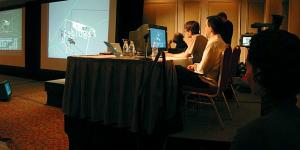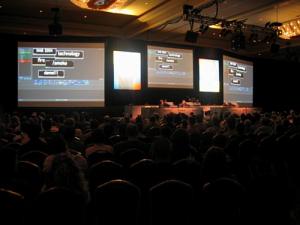The Sunday before NAB was a busy one, with fxguide live2 starting out early in the afternoon and followed up by the discreet users group meeting. The fxguide live event was once again a big success and based upon what was shown afterwards at the discreet event, fxguide live3 will be packed with new features to cover. A special thanks goes out to discreet and sgi, who kindly sponsored the event. Without their support, the event would not have been possible.
 Over 130 artists attended fxguide live2 this year — we actually had to turn folks away due to a lack of space. Well over a dozen countries were represented at the event and from cities both large and small in the US. Thanks so much for everyone’s support of the event and while it is a lot of work to pull off, it is also certainly a lot of fun. It kind of reminds us of the early days of discreet with a smaller community. It is a user-led event about users helping other users…essentially how and why fxguide got started. Based upon attendee comments, it was really well received…
Over 130 artists attended fxguide live2 this year — we actually had to turn folks away due to a lack of space. Well over a dozen countries were represented at the event and from cities both large and small in the US. Thanks so much for everyone’s support of the event and while it is a lot of work to pull off, it is also certainly a lot of fun. It kind of reminds us of the early days of discreet with a smaller community. It is a user-led event about users helping other users…essentially how and why fxguide got started. Based upon attendee comments, it was really well received…
- “Essential event for all users for flame and inferno”
- “More clear than the manual, cheaper than a course”
- “fxguide has become my first priority event at NAB”
- “Fabulous, see you at fxguide3”
 We’re considering doing DVDs of both years events if there is enough user interest. Please email us at fxguide if you’re interested in us developing a DVD of the event.
We’re considering doing DVDs of both years events if there is enough user interest. Please email us at fxguide if you’re interested in us developing a DVD of the event.
After an opening introduction by Jeff Heusser (who ran the tech side of things for the event), Mike Seymour talked about some of the new features in version 5.5/8.5 while walking us through some of his recent work. This included both a practical usage guide for the new Master Keyer, as well as some insanely detailed technical background — including covering such things as “what the hell does Range D mean?”. Based upon feedback from last year, the entire section 2 covered expressions. John Montgomery took attendees through several setups which were provided on a CDROM. These were setups which could be used out of the box but also examined and picked apart to learn more about them. Being a user-led session, two of the setups demonstrated were provided by other users — Alan Fairlie and Jake Parker. Vico Sharabani from rhinofx also showed off some of his recent work which included the use of expressions. Finally, section three was helmed by guest speaker Philippe Soeiro, who concentrated on 10-bit workflow and 3D LUTs, which were due to be shown later in the day at the users gorup meeting.
The fxguide session ran over a bit, and users made the short trip down to the discreet users group meeting to get the scoop on what to expect in the future. This years product demonstrations were a bit different, with users tag teaming along side the discreet usuals Martin Helie and Stephane Labrie. We’ll save some of the cool new fire technology demo features for another article, and cover the upcoming effects release. The inferno demo was a team effort between Helie (aka Mayor of discreet) and Vico Sharabani from rhinofx in NYC. They showcased some of the new features we can expect in the upcoming inferno 6.0/flame 9.0 versions….
Clip history : Probably the all-time top requested feature for the effects products. This allows you do operations (batch supported) on a clip on the desktop and take it into batch and expand the entire history of the clip as a batch graph. Clips with history are labeled with an “H” on the desktop. Double-licking on the “H” takes you to the last module in the history — ready and able for editing. Since setups are attached to clips, there won’t be a need to archive setups and clips separately — information will all be archived to the clip archive (setups saved normally in the individual modules will still need to be archived separately).
SegmentFX (aka clip history in batch edit timelines): Clips in batch can now be considered to contain multiple batch setups, since each clip in an edited timeline can have a history associated with it. For an individual segment in a batch edit timeline, pressing the SegmentFX button drops you into another batch setup in which you can edit the setup which creates the clip. Exiting out of the segmentFX takes you back up a level and you have your newly edited effect intact in the timeline. You can also drag a segment from the timeline to the batch schematic (or to another timeline) and have it expand into a batch flowgraph. This is very cool and will dramatically change the way we work. SegmentFX clips can be treated as normal clips in batch, with all editing features available.

Custom nodes/Improved Grouping: Artists are now able to save a group of nodes as a custom node in the node bin. These can be either user-centric or project-centric. With the improved grouping features, you can determine what inputs are available, what UI features are available (you could, for instance, decide to show the UI for some nodes in the group and not for others). You can also decide which outputs to show and which outputs to hide. This will be very nice for frequently-used functions.
Notes in batch: Nodes and clips can now have notes attached to them in the batch schematic. Notes are available on a per-clip or node basis as well as a general schematic note.
Paint in batch: Martin showed a new layer-based paint node in batch. It was a brief demo, but it appeared as though many of the basic tools were present in the software.
3D LUTS: 3D display LUTS will be available in batch….important to note that they are for display purposes. At the earlier fxguide live2, Philippe Soeiro showed some very dramatic examples of how 3D LUTS can provide improved display of files in the software.
Spline-based warper: There is a new spline-based warper in inferno/flame. The features of the splines appear to be very similar to the gmask tools, including the ability to draw a spline by dragging and having the software create the needed tangent points for you. It also provides the ability to view correspondence points — how the source and destination splines relate to each other. As a frame of reference, the warper appears to be similar in functionality to the now-dormant Elastic Reality.
“Divide” in action: Divide is now available on a layer basis in action, so you no longer have to deal with keyer workarounds to work with premultiplied graphics.
Channel editor improvements: Martin showed several channel editor improvements, including the ability to select and move myltiple keyframes while in “Track” viewing mode. He also showed how you can now change the adjustment values for curves (simplify, translate, etc) by scrolling through the box and see the channel editor curves dynamically change.
Photoshop import: You’ll be able to import Photoshop files directly in action and have the layers and positioning intact. Each layer is assigned an axis and blending mode which is supported in the software.
Soft clip import: You can now “soft import” a clip from the filesystem. The clip is not actually imported into the stonefs, but continually referenced from the irix filesystem. This allows changes to be made to the image sequence (such as someone replacing them using ftp) and have them transparently updated within the effects software. For instance, if your 3D artists re-renders a sequence and places the new image sequence in the same place with the same name, you’ll have immediate access to the new frames without having to re-import.
G-Mask Motion Blur: Motion blur will be available in gmasks, on a vertex by vertex basis.
Coming up in part 2 — extremely cool editing technology demonstration…..
